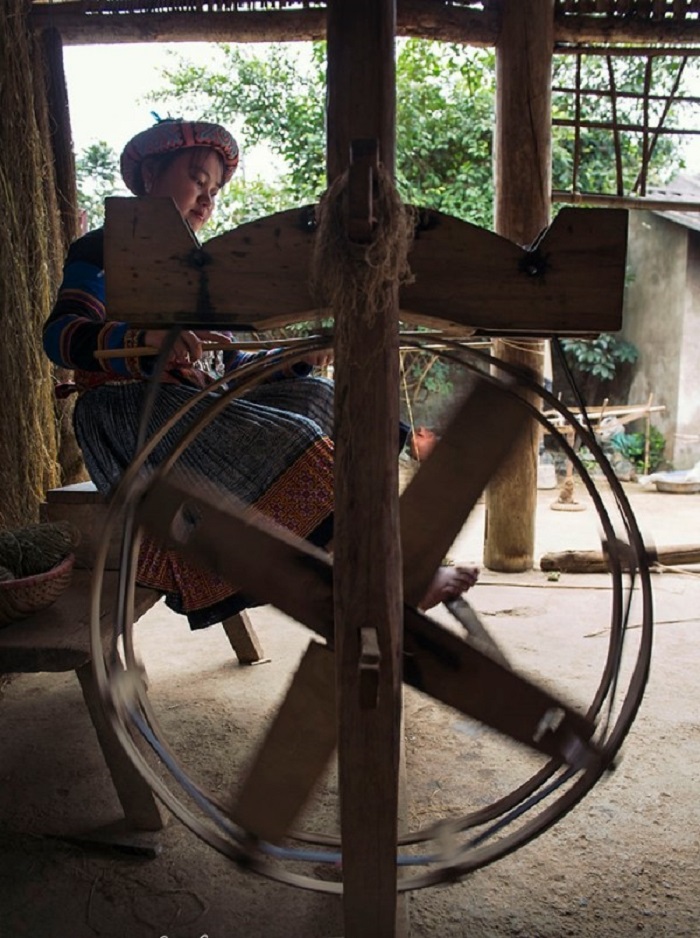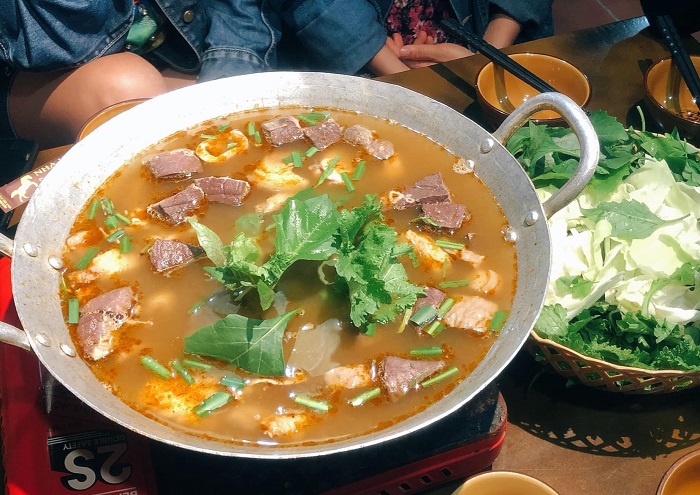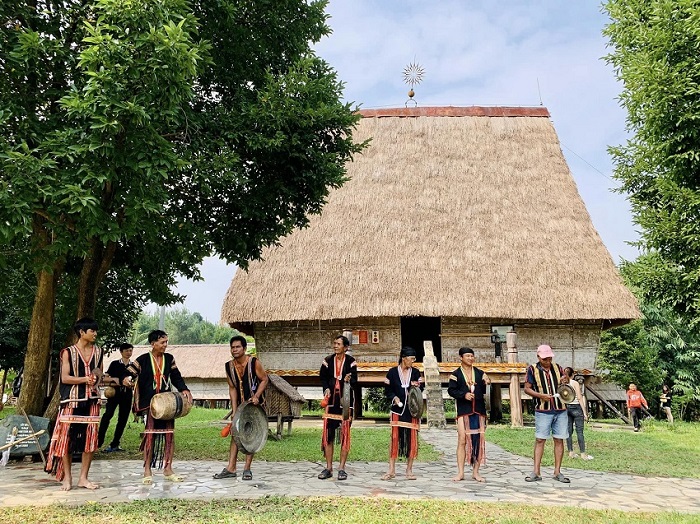Vietnam National Village for Ethnic Culture and Tourism showcases the unique culture of 54 ethnic groups
Visitors do not have to travel far from Hanoi to get a sense of the ethnic minorities living in northern Vietnam.
The Dong Mo tourist area in Son Tay Town, a suburb of Hanoi, has a much livelier atmosphere on days around mid-April every year. On other days, the locals are barefoot farmers, but on those days, when ethnic minorities from the surrounding areas gather, the area comes alive with a market and an art space.
| The joyful atmosphere to celebrate Vietnam's Ethnic Groups Cultural Day (April 19) at Vietnam Ethnology Cultural and Tourist Villages. Photo: VNA |
The annual festival to celebrate Vietnam's Ethnic Groups Cultural Day (April 19) will be held from April 14 to 19 at the Vietnam Ethnology Cultural and Tourist Villages. With the theme "Colors of the Cultures of Vietnamese Ethnic Groups", the week-long festival brings a joyful atmosphere to locals and international visitors alike.
Bright colors of Vietnamese ethnic groups
At 6.30am, buses full of tourists and guests start arriving at the Vietnam Ethnology Cultural and Tourist Villages, about 40km from the center of Hanoi. The tranquil place is buzzing with visitors, and soon the sound of gongs, panpipes, and other instruments fills the morning air. A group of ethnic Thai girls in beautiful white, form-fitting traditional dresses perform the mua sap (dance between bamboo poles). Elsewhere, an ethnic Yao man is applauded for his enchanting singing.
Impressed by a group of Flower H'Mong girls who had donned their colorful outfits in hopes of meeting boys, my friend and I decided to join the group. Ignoring the excitement of the young girls, an elderly H'Mong mother was busily weaving a piece of cloth. The clothes of the ethnic minority, especially those of the women, express their industriousness, cleverness, and sense of beauty. It seems that the ethnic minority is one of the few people in the world who still make most of their own clothes.
"It takes 21 stages to make our dress, from planting the lin tree to weaving the cloth and then decorating the clothes with hand embroidery," Giang Thi Mua, 55, a Flower H'Mong woman from Quan Ba commune in northern Ha Giang province shared with The Hanoi Times.
| Linen spinning and weaving have been passed down from mother to child in the families of the H'Mong ethnic group in Vietnam. Photo: Thuong hieu & Cong luan |
When she was six, the woman's mother showed her how to complete each stage. She does her needlework while working on the farm or watching the family's buffalo graze when she has free time. It can take a month to complete a dress if she works continuously or up to six months if she works only when she has time. The elderly H'Mong woman, like many others, has failing eyesight.
Mua said red is used extensively because the H'Mong believe the color is a symbol of strength, happiness, and good fortune, as well as a protection against evil.
On an indigo background, the collars and sleeves of women's dresses are embroidered with elaborate patterns. The pleats of the skirts symbolize the mountains of their homeland, and the patterns are said to follow ancient H'Mong calligraphy. Other patterns come from nature - images of plants, domestic animals, the moon, and the sun. The fabrics are also decorated with small silver beads or bells.
"A H'Mong bride's dress is made by her mother, and its complex patterns express her family's health and social status," said Mua.
The dress becomes her most prized possession, and she will wear it again when she's buried so that her mother will recognize her in the afterlife.
Time for ethnic specialties
| Visitors to Vietnam Ethnology Cultural and Tourist Villages these days will have chance to try thang co or horse hotpot, a specialty of H'Mong group. Photo: Sapa Review |
Standing next to a boiling pot of thang co (horse hotpot), Lo Huy Gia, 40, a H'Mong man from Ha Giang's Meo Vac town, introduced himself as the "most famous" thang co vendor at the Meo Vac village fair.
His huge pot of thang co, worth about VND5 million or around US$220, is always empty at the end of the fair. It was only 3 pm and the hot pot was almost gone," he said.
A popular traditional dish of the H'Mong people, thang co can be found in every mountain market in northern Vietnam. It's quite likely that the uninitiated would find the original thang co unappetizing due to its unpleasant smell and taste. Knowing this, restaurateurs have made some changes to suit the tastes of both local and foreign tourists.
To make a tasty thang co, Gia said he had to travel far to minority markets to buy ponies and mature goats. They get up in the early hours of the next day to slaughter the animals and cut their meat, bones and intestines into pieces to make a stew served in a large hot pot.
To sample the dish, diners use their chopsticks to pick the meat and intestines, then dip them into a bowl of spicy sauce.
"It's certainly an acquired taste, made easier to eat when accompanied by copious amounts of corn wine," Thang Do, a traveler from Ha Nam Province told The Hanoi Times.
According to H'Mong ethnic people, the dish of thang co is flavored with salt and spices such as thao qua or cardamom and dia dien or pineapple peel, giving the dish a spicy, sweet aroma. People usually eat thang co with men men, a traditional bread made from corn flour.
Because the dish is served in a large bowl, ethnic people never eat thang co alone. They usually sit at low tables on mats in restaurants and enjoy the dish with corn wine or other wine. At ethnic minority markets, such as the one in Meo Vac, thang co is a favorite of the men, who like to gather around a fire and the large hot pot, sipping thang co, chatting, and drinking wine from morning until afternoon.
A funky tourist attraction
| The space of Central Highlands' gong performance in the in Vietnam Ethnology Cultural and Tourist Villages. Photo: Vinaculto |
Covering an area of 1,500 hectares in Dong Mo Tourism Site, Ba Vi Commune, Son Tay Town in Hanoi, about 42 km from the city center, the Vietnam Ethnology Cultural and Tourist Villages is a complex of traditional Vietnamese architecture that highlights the unique characteristics of the country's culture.
It includes an Ede long house, a Tay stilt house, a Yao house half on stilts and half on the ground, a Hmong house with a roof made of pomu or fokienia wood, a Viet house with a tile roof, a Jarai tomb, a Bahnar communal house, a traditional Cham house, and a Hanhi house made of beaten walls.
Between the houses are indigenous trees, zigzagging paths, and a meandering stream crossed by small bridges. Visitors can explore on foot or by electric car.
From the Big C Supermarket on Tran Duy Hung Street, enter Thang Long Boulevard, drive for 7km, then turn right and follow the signs to Lang Van Hoa until you see the village logo on a large red sign in the middle of the road.
Vietnam National Village for Ethnic Culture and Tourism
Address: Dong Mo Tourism Site, Son Tay Town, Hanoi

.jpg)













